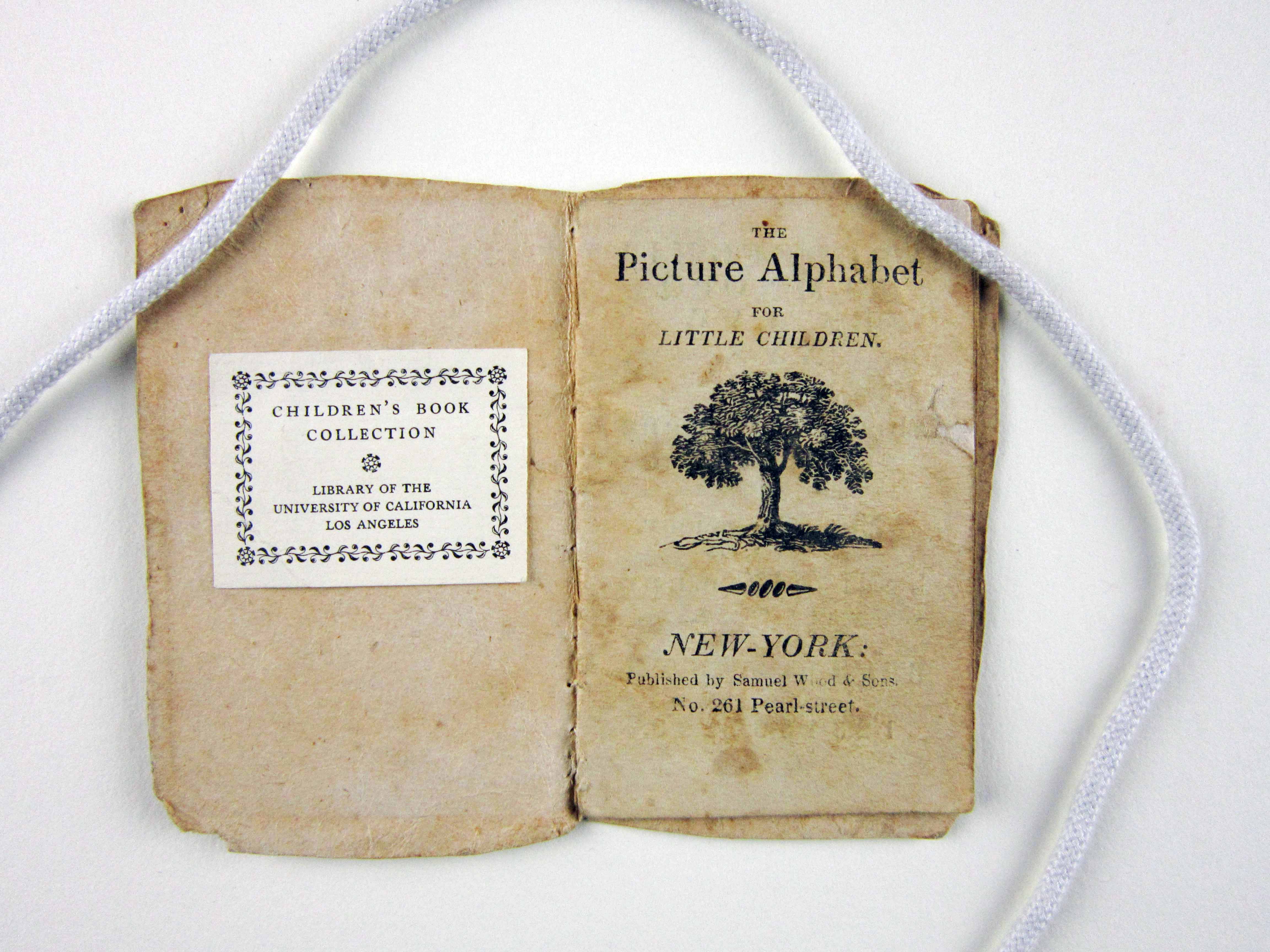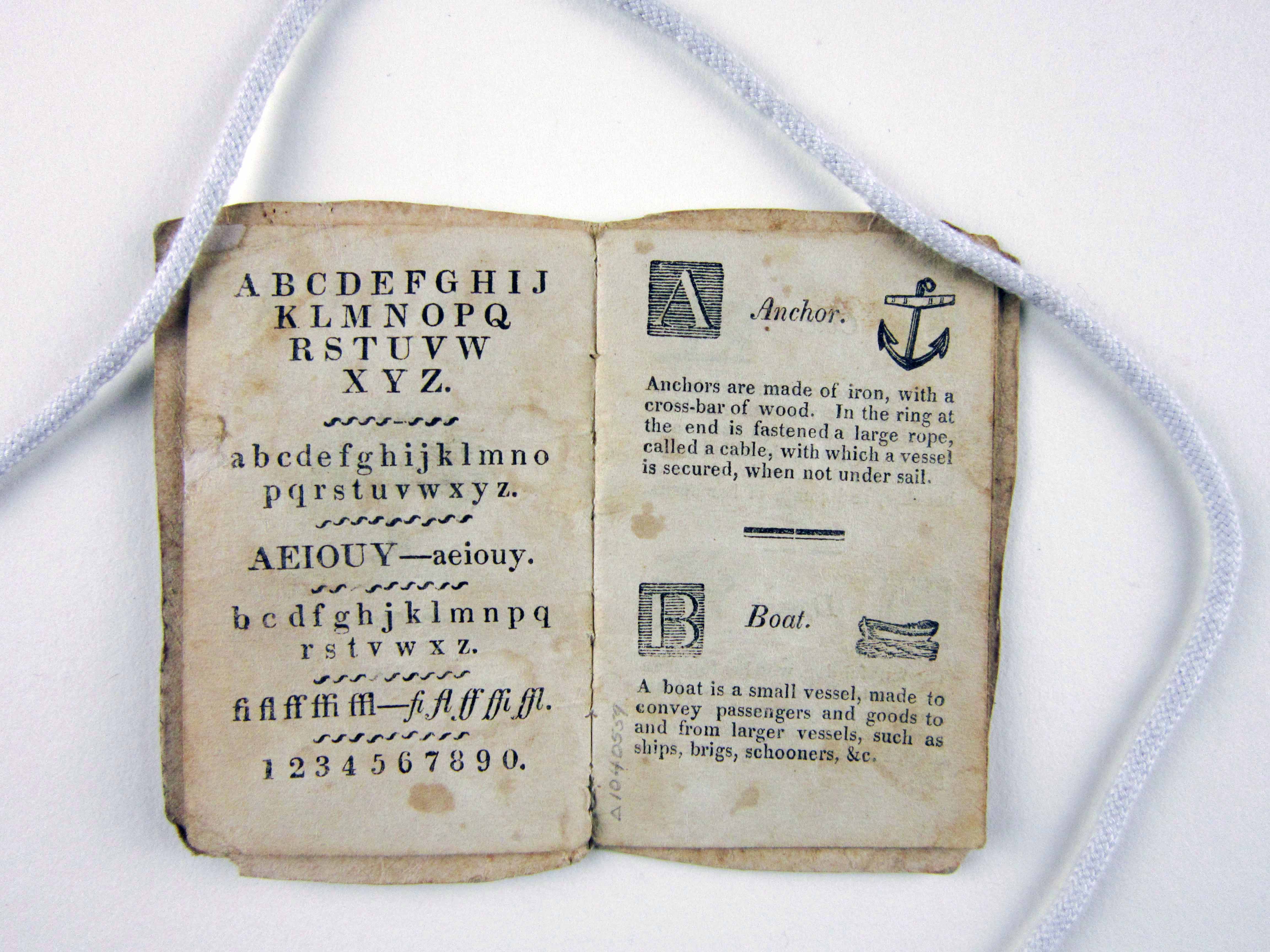

Alphabet books offer a vivid insight into the history of literacy and culture, as well as concepts of childhood. The Children's Book Collection at UCLA contains a rich array of these materials, some well-worn and much-used, some still bright and fresh. Each is a gem of print production and graphical imagery from another time and place. Though the history of alphabet books continues to the present, this exhibit focuses on the works in our collections published between 1700 and 1900, including horn books, primers, works of didacticism and seriousness, whimsy and play.
2. A Jumble ABC
3. A Little Pretty Pocket-Book
4. A New Lottery Book of Birds And Beasts
5. A Pretty Play-Thing for Children of All Denominations
8. ABC of Objects for Home And School
10. ABC with Pictures & Verses
12. Alphabet Et Instruction Pour Les Enfans
16. Dolly's ABC Book
17. Flora's ABC
18. Home ABC
22. Hornbook C. 1700
23. Large Letters for the Little Ones
24. Little ABC Book
25. Little People: An Alphabet
26. Martin's Nursery Battledoor
27. Mother Goose ABC
28. My Darling's ABC
29. Orbis Sensualium Pictus Quadrilinguis
30. People of All Nations: A Useful Toy for Girl Or Boy
31. Picture Alphabet
32. Pretty ABC
33. Railway ABC
34. Rusher's Reading Made Most Easy
38. The Alphabet of Old Friends
40. The Amusing Alphabet for Young Children Beginning To Read
42. The Child's Christian Education
45. The Easter Gift
47. The Favorite Alphabet for the Nursery
49. The Franklin Alphabet And Primer
51. The Golden ABC
55. The Moral And Entertaining Alphabet
57. The Old Testament Alphabet
59. The Picture Alphabet for Little Children
62. The Sunday ABC
63. The Union ABC
64. The Young Child's ABC, Or, First Book
65. Tom Thumb's Alphabet: Picture Baby-Books
67. Warne's Alphabet And Word Book: with Coloured Pictures
68. Wood's Royal Nursery Alphabet
Title The Picture Alphabet for Little Children


Brief description Woodcuts: title vignette and illustrations. Publisher's advertisement on p. [16] Each letter in 26-letter alphabet accompanied by illustration and one sentence of text. Buff wrappers.
Full description This tiny book is an excellent example of a chapbook. Chapbooks were cheaply produced and easily packed into bundles for distribution throughout the country by peddlers. This chapbook not only teaches the alphabet, but also contains illustrations of words that begin with each letter and a sentence or two about the word. It is much like a child's picture alphabet dictionary of today. Particularly notable, this book depicts and defines objects and animals that were popular in the early nineteenth century in New York. Children reading this chapbook would have to have been familiar with all the depictions held within it for the book to work as a pedagogical tool.
Literacy Literacy was slowly catching on in the early nineteenth century. Yet the term literacy did not hold the same meaning it does today. Many people were literate in the sense that they could read, but many still could not write. Some people during this time were able to make a "mark," which in today's terms meant they were able to sign documents. Yet a "mark" does not indicate a full written signature, and thus means that many people (including children) could read, but were not able to write.*The format of the book suggests that the child used it during different stages of literacy--learning the alphabet and numbers before being able to read the words, and finally the descriptions. After the initial page of letters and numerals, the book is formatted as a dictionary of different animals and objects. In formatting the book this way, the child was not only encouraged to become literate in the sense of learning to read, but was also becoming culturally and visually literate.*The norms of society and the culture surrounding it are reflected in the words, illustrations and definitions used. The culturally literate person in the early nineteenth century knew that an anchor is "made of iron, with a cross-bar of wood" and that "turkey flesh is excellent." The child reading this book was taught reading and comprehension of the culture of the time. The book also gave the child a greater command of how society functioned during this time, for example in the definition of a key, "... if everybody were honest, there would be no need for either locks or keys."
Childhood The chapbook is tiny and meant for tiny hands to peruse. Childhood is conveyed through the dictionary-like format, as well as the compact size of the book. The back cover tells us that the book is meant for "amusement and instruction." The notion of childhood was still in its infancy in the early nineteenth century and although this book tells us that it will entertain the child with pictures and definitions, the book is an instructional tool above anything else. Clearly there is an idea that the child should not solely be reading for pleasure but will be gaining instruction through the words and pictures held within this book. During the time of publication of this chapbook, many other chapbooks were printed as well. The child reading this one was not being entertained with fairytales, but given insight into the world around them, by describing and picturing items and objects that they would encounter.
Iconography The notice on the back of The Picture Alphabet for Little Children reminds us that this book (and others published by the publisher) is not simply for the amusement of the child, but also for instruction. The vocabulary presented is not technical in nature but simply written, and depicts the usefulness of each item or animal illustrated. For example, a hive is "a small house made of wood or straw for bees. These little insects work through the summer to fill their hives with honey for which we kill them in the fall." Not only does the small paragraph describe the hive, but the child is also being taught of the use of honey and that once the honey is harvested the bees are not useful to humans.*The child learning from this book is reminded of what is expected of them as a youth in society. A youth in this society was expected to be a good son and pious Christian, one who had a relationship with God and strove to be a good pillar of society.
Production This book was published and printed by J.G. Rusher in Banbury, England. The technique used to print the text is letterpress, with illustrations made with woodblocks. In the early nineteenth century many books for children were produced in the form of chapbooks. The reason for this is that chapbooks were cheaply made and sold by peddlers who came to town with multiple copies of the same book, enabling people to buy books inexpensively and without the bother of traveling to a store. Chapbooks for children came in many different forms; some were early fairytales while others were nursery rhymes. The content of the chapbooks contain much insight into the readership and the teaching methods of the parents purchasing chapbooks.*J.G. Rusher, who published this chapbook, was a noteworthy publisher during the nineteenth century. C.R. Cheney says in his article, entitled Early Banbury Chap-Books and Broadsides that, "collectors of popular literature of the early nineteenth century are well acquainted with the publications of John Golby Rusher." He published many chapbooks, such as this one. Before publishing chapbooks, Rusher published Banbury directories in the late eighteenth century which consisted of lists of fairs and transport services in the area of Banbury and was published in book form.
Creator
Publisher Samuel Wood & Sons
Publication place New York
Date 1817
UCLA Call Number CBC PE1119.A1 P5308 1817
Repository UCLA Charles E. Young Research Library, Dept. of Special Collections
Dimensions 89 mm
Technologies of production Woodcut (process)
Caption